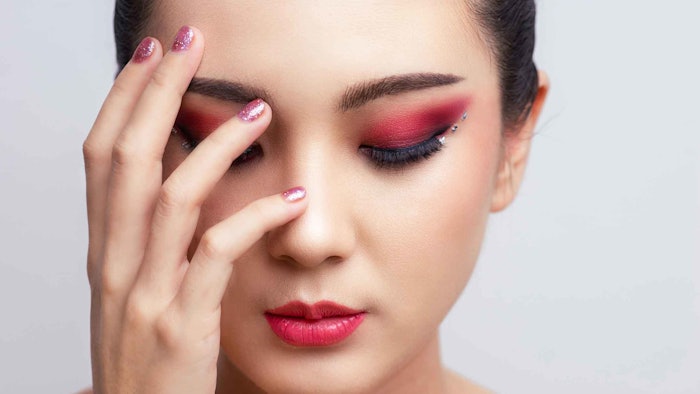
A few months ago, Global Cosmetic Industry reported1 that like hair care, makeup’s recent boom has been driven by skin care-inspired innovation across product categories. Per the source, Circana reported 53% of makeup users look for hybrid makeup/skin care products – which is up 6% compared to 2022. In relation, a 2022 survey from Mintel, cited by Vantage, found 70% of U.S. female makeup users want multifunctional products.
To better understand these cross-category dynamics, Global Cosmetic Industry reviewed a range of recent hybrid cosmetic launches to decode future innovation opportunities for brands. For example, Tula Skincare moved into the concealer category with a 20-shade range of its Radiant Skin Brightening Serum Concealer. The formulation is said to offer an eye treatment with brightening benefits and includes, among other ingredients, rainbow seaweed, niacinamide, probiotic extracts and three prebiotics derived from chicory, beet and turmeric root to address dark circles, skin texture, eye bags and strengthen the skin barrier.
Apostle launched the 12-shade range of Reclaim Tinted Moisturizers for the face, providing medium coverage and a matte finish while boosting skin elasticity, firmness and hydration. They also are said to diminish the appearance of fine lines and defend against stressors. In addition, Topicals’ Sealed Active Scar Filling Primer for Acne Prone Skin offers a matte finish and reportedly fills in and smooths the look of indented acne scars and large pores. Longer term use can also reduce the appearance of scar depth, per the brand.
R.E.M. Beauty’s long-wearing Sweetener Foundation features a blend of raspberry leaf extract and hyaluronic acid spheres to deliver instant hydration that reportedly lasts up to four weeks. The formulation also comprises niacinamide to reduce the appearance of pores, correct dullness and mattify and brighten skin. And, MAC’s Studio Radiance Serum-Powered Foundation, available in 48 shades, was formulated to blur the appearance of pores, smooth the skin’s texture, even out tone and hydrate. These are just a few examples from Global Cosmetic Industry’s full report.1
Moving forward, Mintel believes2 that as new generations of consumers enter the color cosmetic category, brands must be ready to accommodate their shifting attitudes and behaviors in terms of social media discovery, skin health and shopping preferences. In the report, “Color Cosmetics – US – 2004,” the firm observes that “top cosmetic purchase influencers mimic that of other beauty and personal care categories, showing the mergence, hybridization and holistic approach users take when purchasing within the category. As makeup users cite their facial skin care priorities, brands must promote skin-beneficial attributes across all cosmetic formats to cohesively live within total beauty and personal care rituals in the long term.”2
From their hybridization to full integration into consumer rituals, color cosmetics are re-emerging with a new purpose beyond mere aesthetics. We asked a few industry experts to weigh in on this market direction; following are their insights.
Mentally Relaxing and Increasingly Sophisticated
Jasmine Shah, marketing manager of skin care for Clariant, writes, “Increasingly educated consumers, who nonetheless face socioeconomic uncertainty, continue to turn to beauty and personal care products – demonstrating a willingness to invest in their appearance alongside use of personal care as a way to mentally relax.”
Shah adds that there is a vested focus on quality, performance and convenience, particularly in the realm of color cosmetics. “Today’s consumers seek out color cosmetics that, in addition to aesthetic performance, provide skin care benefits, a nice sensory experience and ultimately also enable them to streamline their routines. For the makeup sector, this translates into the rise of multifunctional color cosmetic products, such as cream tints that can be used on the lips, the cheeks and the eyelids, or hybrid serum foundations.”
In terms of future directions, Shah believes that as the skinification trend continues to evolve, hybrid products will become the norm. “Skin care and color cosmetics will continue to merge, which means that color cosmetic brands will produce increasingly sophisticated formulations – for instance, including hero skin care actives and UV filters in makeup – to provide the key benefits demanded by consumers.” She adds that this creates immense potential for functional ingredients that enable makeup formulations containing hero actives and UV filters.
According to Shah, functional ingredients will play a pivotal role in supporting this future market direction. “For instance, [Clariant’s] emollient Plantasens Pro LM (INCI: Lauryl/Myristyl Polyricinoleate (and) Glycerin) has excellent pigment wetting and dispersion abilities, as well as compatibility with chemical UV filters,” Shah writes. “This property means it can be incorporated into color cosmetic products alongside UV filters while nourishing the skin. Similarly, our rheology modifier Aristoflex Silk (INCI: Sodium Polyacryloyldimethyl Taurate) can stabilize active ingredients, all while imparting a desirable skin feel and thickening formulations, which make it a great addition to hybrid products.”
Eco-friendly with Color Integrity
Patrick Foley, president of P2 Science, Inc., sees efficacy and eco-friendly facets as key to color cosmetic solutions. “In general, performance is still the market driver, recognizing that sustainability is increasingly becoming a key performance criterion alongside things like color integrity, brightness and lightfastness,” Foley writes. “These drivers are going to require continued ingredient innovation to meet increased expectations among formulators and consumers alike.”
Foley adds that for younger consumers in particular, influencers and social media continue to drive trends. “One trend of note is toward a more natural look that de-emphasizes masking and camouflaging. This will have consumers looking to cream-based products (e.g., tints and bronzers) that can be blended into the skin for a subtler aesthetic.”
What does this mean for future directions in this space? “[T]hese trends point to a need for high-performance, multi-functional color ingredients that have a robust sustainability profile,” he explains. “As such, there is a growing potential for pigments that minimize or eliminate the use of non-sustainable functional dispersants. [T]here is [also] further need for these dispersants be able to deliver better color without sacrificing the desired sensory and long-lasting benefits, otherwise formulators need to compensate with additional modifiers.”
To enable these trends, Foley points to P2’s new Citropol platform (INCI: Polycitronellol), which includes the Citrosperse line of color dispersants, and per Foley, makes huge strides toward addressing all of the formulator’s emerging needs. “These bio-based liquid polymers can deliver pigment at higher loadings, with faster wetting times than traditional dispersants, all while maintaining a highly desirable sensory feel on the skin.” Foley adds that for formulators who have not yet tried these dispersions, their performance is evident after using them just once. “True innovations like these are going to drive successful product launches into the future.”
Hybridized and Sensitive Skin/Gray Beauty-focused
“As busier lifestyles pick back up, consumers are looking at products that are convenient to use, but also easy on the wallet,” observes Cilver Tiffany Coleman, technical marketing specialist at Vantage. “Hybrid products, or makeup with skin care benefits, are incredibly appealing to consumers as they align with desire for convenience and cost.”
Coleman adds that as cosmetics begin to take on a more skinified route, there is huge potential for makeup [for] consumers with sensitive skin and those who are within the 55+ demographic. “Former trends like ‘grey beauty’ – which highlights beauty products and marketing suited for mature women – will make a resurgence in both marketing and product development.”
According to Coleman, ingredients such as comforting, moisturizing natural emollients offer formulators tools to develop such products. “Liponate Jojoba 20 (INCI: Jojoba Esters) [is] perfectly suited for hybrid makeup due to [its] high compatibility with pigments. Clinical studies show that these jojoba esters significantly contribute to increasing skin hydration and reducing skin irritation,” Coleman writes.
In addition, oil-soluble technologies for skin barrier support lend themselves to future color cosmetics. “StrataPhix AOS (INCI: Caprylic/Capric Triglyceride (and) Camellia Sinensis Leaf (and) Lithospermum Erythrorhizon Root Extract (and) Haematococcus Pluvialis Extract (and) Glycyrrhiza Glabra (Licorice) Root Extract), a powerful antioxidant, will help drive further the trend of hybrid makeup, especially for consumers in the 55+ demographic or those with more sensitive skin,” Coleman adds.
Conclusion
Color cosmetics have risen above their pigmented bases to turn their once-perceived effects on skin into physical realities.
References
1. Global Cosmetic Industry. (2023, Oct 30). Color cosmetics’ skin-forward revolution. Available at https://www.gcimagazine.com/brands-products/color-cosmetics/article/22877755/color-cosmetics-skinforward-revolution
2. Kitzmiller, C. (2024). Color cosmetics – US – 2024. Mintel. Available at https://clients.mintel.com/download/brochure/color-cosmetics-us-2024











